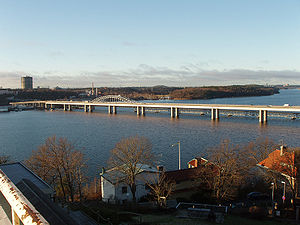
Lidingöbron
Encyclopedia

Lilla Värtan
Lilla Värtan or simply Värtan is a strait in Stockholm, Sweden. Separating mainland Stockholm from the island and municipality Lidingö, it stretches from Blockhusudden in the south to Stora Värtan in the north...
between the mainland Norra Djurgården at Ropsten
Ropsten
Ropsten is a cape at the eastern part of Stockholm mainland at the inner part of Stockholm archipelago in Sweden. Two bridges named Lidingöbron extend from Ropsten over to the island of Lidingö. Ropsten area is located between Hjorthagen and the Stockholm city main port Värtahamnen...
, at the eastern part of Stockholm
Stockholm
Stockholm is the capital and the largest city of Sweden and constitutes the most populated urban area in Scandinavia. Stockholm is the most populous city in Sweden, with a population of 851,155 in the municipality , 1.37 million in the urban area , and around 2.1 million in the metropolitan area...
- and the island of Lidingö
Lidingö
Lidingö is an island in the inner Stockholm archipelago, located north east of central Stockholm, the capital of Sweden. It is also the seat of Lidingö Municipality, Stockholm County, Sweden with 44,000 inhabitants in 2011....
.
First pontoon bridge
At a parish meeting in 1802, the inhabitants of Lidingö, at the time a mostly agricultural district, decided to open a venture to realize a pontoon bridgePontoon bridge
A pontoon bridge or floating bridge is a bridge that floats on water and in which barge- or boat-like pontoons support the bridge deck and its dynamic loads. While pontoon bridges are usually temporary structures, some are used for long periods of time...
connecting the island to Stockholm. The 50 shares of the company had to be redeemed by contributing to the project with timber, work, or money and the bridge was completed in 1803; almost 800 metres long, 7 metres wide and financed by tolls. It was one of the longest bridges in Europe, and it was located around 2 km south of the present bridges. It had a hard time surviving the annual ice break-up, and a third of it was demolished in 1811, and most of it in 1858 - each time raising the price for milk in the capital, as most of it was produced on Lidingö at the time.
Second pontoon bridge
With the creation of the harbour of VärtanVartan
Vartan may refer to:* Vartan , an Italian comic book published from 1969 to 1977Vardan is an Armenian name and may refer to:People with the surname Vartan:* John Vartan* Michael Vartan* Sylvie Vartan...
, the original bridge obstructed shipping in the strait, and it was therefore bought by the city of Stockholm in 1883 who replaced it 1884 with a new pontoon bridge
Pontoon bridge
A pontoon bridge or floating bridge is a bridge that floats on water and in which barge- or boat-like pontoons support the bridge deck and its dynamic loads. While pontoon bridges are usually temporary structures, some are used for long periods of time...
, 12 metres wide and with two moveable sections at each end for the passage of ships. This bridge was located near the present bridge. The level of the roadway was only 10–15 cm over the water surface however, so even moderate winds made crossing the bridge a tough experience. The lateral stability of the bridge was ensured by means of logs attached to the bridge every 24 metres and anchored to the bottom. The use of logs instead of chains effectively increased the bridge's general buoyancy at the cost of its stability during low tide - the bridge often serpentined its way across the water while the inclination of the roadway at the two ends made use of extra horses necessary. Heavy truck
Truck
A truck or lorry is a motor vehicle designed to transport cargo. Trucks vary greatly in size, power, and configuration, with the smallest being mechanically similar to an automobile...
s started to use the bridge, for which it was not constructed. Ice break-up destroyed a third of the bridge in 1918.
Old Lidingöbron
By the end of World War I, the increasing number of motor cars made a more able bridge necessary, and by 1925 a steel truss bridgeTruss bridge
A truss bridge is a bridge composed of connected elements which may be stressed from tension, compression, or sometimes both in response to dynamic loads. Truss bridges are one of the oldest types of modern bridges...
, 9,1 metres wide with a 6,7 metres roadway, finally replaced the second pontoon bridge. It had two railway tracks in the same carriageway as the road.
To avoid foundation work at the maximum depth a 140 metres long truss arch was used, and to allow a horizontal clearance of 5,3 metres the bridge was provided with a simple 20 m long flap.
After the new bridge was built, cars are not allowed on the old bridge. It has one rail track which is now considered a tramway, Lidingöbanan. The other half of the bridge is used for bicycles and pedestrians.
New Lidingöbron
The population of Lidingö as well as the traffic continued to grow however, and by the 1950s the old bridge had become insufficient. The two municipalities met in 1961, and the following year it was settled a new bridge should be located south of the old. The new bridge, inaugurated in 1971, is 997 metres long, 24 metres wide, and offers a horizontal clearance of 12,5 metres while the roadway passes 75 metres above the bottom of the strait. The part of the bridge passing over water, 724 metres long, is made of double box girderBox girder
A box or tubular girder is a girder that forms an enclosed tube with multiple walls, rather than an or H-beam. Originally constructed of riveted wrought iron, they are now found in rolled or welded steel, aluminium extrusions or pre-stressed concrete....
s with a maximum span of 73,5 metres, the entire construction resting on steel poles filled with concrete.

